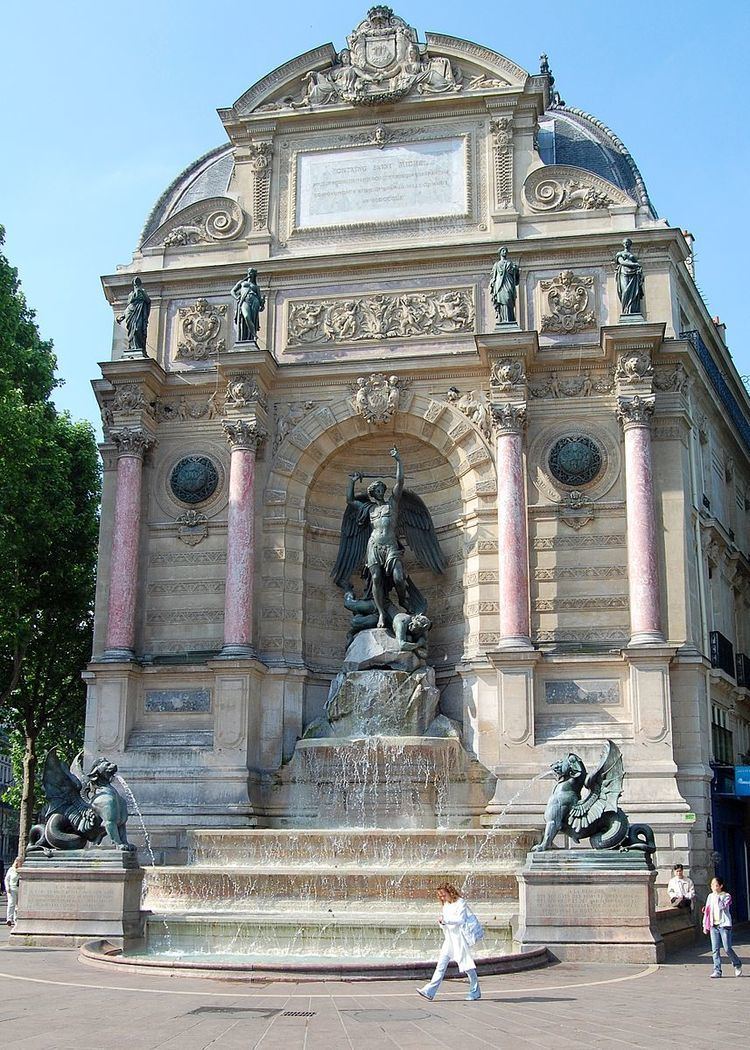Phone +33 1 40 46 75 06 | ||
 | ||
Address Place Saint-André des Arts, 75006 Paris, France Hours Open today · Open 24 hoursTuesdayOpen 24 hoursWednesdayOpen 24 hoursThursdayOpen 24 hoursFridayOpen 24 hoursSaturdayOpen 24 hoursSundayOpen 24 hoursMondayOpen 24 hours Similar Pont Saint‑Michel, Saint‑Jacques Tower, Saint‑Germain l'Auxerrois, Fontaine des Innocents, Saint‑Michel | ||
Fontaine saint michel de paris b
The Fontaine Saint-Michel ([fɔ̃.tɛn sɛ̃.mi.ʃɛl]) is a monumental fountain located in Place Saint-Michel in the 5th arrondissement in Paris. It was constructed in 1858–1860 during the French Second Empire by the architect Gabriel Davioud.
Contents
History
The fontaine Saint-Michel was part of the great project for the reconstruction of Paris overseen by Baron Haussmann during the French Second Empire. In 1855 Haussmann completed an enormous new boulevard, originally called boulevard de Sébastopol-rive-gauche, now called Boulevard Saint-Michel, which opened up the small place Pont-Saint-Michel into a much larger space. Haussmann asked the architect of the service of promenades and plantations of the prefecture, Gabriel Davioud, to design a fountain which would be appropriate in scale to the new square. As the architect of the prefecture, he was able to design not only the fountain but also the facades of the new buildings around it, giving coherence to the square, but he also had to deal with the demands of the prefet and city administration, which was paying for the project.
Davioud's original project was for a fountain dedicated to peace, located in the center of the square. The prefect authorities rejected this idea and asked him instead to build a fountain to hide the end wall of the building at the corner of boulevard Saint-Michel and Saint-André des Arts. This forced Davioud to adapt his plan to the proportions of that building.
The next design made by Davioud in 1856 provided the architectural structure of the fountain; a facade divided into four horizontal levels, similar to a triumphal arch, with four Corinthian columns on high socles framing the central niche. The main cornice is surmounted by a French Renaissance design feature, an inscribed tablet in a grand architectural framing. As the revised site was just off the axis of the bridge, Davioud created a visual compromise in a series of shallow bowed basins through which the water issuing from the rock under the supine body of Saint Michael's adversary spills. The water ends in a basin sunk into street level, with a curving front edge that softens the line of the monuments architectural base.
In the 1856 plan, Davioud placed a feminine statue of Peace into the central niche. The 1858 plan called for replacing Peace with a statue of Napoleon Bonaparte. This provoked furious opposition from the opponents of Louis-Napoleon, so later in 1858 Davioud proposed that the central figure be the Archangel Michael wrestling with the devil. This was agreed, construction began in June 1858, and the statue was inaugurated on August 15, 1860.
In September 1870, after the capture of Emperor Louis Napoleon by the Germans during the French-German War and his abdication, the fountain was threatened by a mob. On September 5, Davioud wrote an urgent letter to the Director of the Municipal Service of Promenades and Plantations: "A crowd of unarmed workers have just come to the Fontaine Saint-Michel..they apparently want to attack the fountain and want to deface the eagles and inscriptions on the upper part. What should I do?"
The fountain, along with other symbols of Louis Napoleon, was apparently attacked and damaged by mobs during the 1871 uprising and suppression of the Paris Commune. In 1872, Davioud was authorized by the Prefecture to make urgent repairs to the fountain. It was restored again in 1893.
The Decoration of the Fountain
Davioud was himself a trained neoclassical sculptor from the Ecole des Beaux-Arts, and the large scale (26 meters by 15 meters) and the elaborate iconography he created for the fountain required the work of nine different sculptors. It features:
Four statues representing the cardinal virtues:
The fountain was different from most other Paris fountains because it used different colors of stone; columns of red marble from Languedoc; green marble; blue stone from Soignies; yellow stone from Saint-Yllie; and bronze statues.
Critical reaction
The critical reaction to the fountain when it was opened in 1860 was divided. Much attention was given to the different colors: The critic of Le Monde Illustré wrote: "the monument constitutes, in sum, a venture into polychrome architecture such as one can see in Rome, where fountains of the same style were created by artists of the 18th century."
The critic Alfred Darcel in Gazette des Beaux-Arts was less enthusiastic: he condemned the fountain for its choice of colors, its composition, what he called its incoherent style and iconography, and because, in his view, the concentration of so many different statues by different artists nullified the individual talents of the artists.
Other critics condemned the statue for its placement against a wall, instead of in the center of the Square. It was, said one, "a placement frequent in Paris, but vicious for monuments of this grandiose style."
In fact, the Fontaine Saint-Michel was the last monumental wall fountain built in Paris, the end of a traditional Renaissance style which had begun with the Medici Fountain in the 17th century and continued with the Fontaine des Quatre-Saisons in the 18th century. The later monumental fountains in Paris were all free-standing, in the centers of squares or parks.
